![]()
![]()
![]()
Use LEFT and RIGHT arrow keys to navigate between flashcards;
Use UP and DOWN arrow keys to flip the card;
H to show hint;
A reads text to speech;
114 Cards in this Set
- Front
- Back
- 3rd side (hint)
|
Ecology |
the study of the environment and how organisms interact with each other and abiotic factors. |
|
|
|
Biotic |
livingcomponents of an ecosystem such as plants, animals, bacteria and fungi.
|
|
|
|
Abiotic |
non-living components of an ecosystem such as; air, water, light, andtemperature.
|
|
|
|
Producer |
organism that can create its own food such as a tree
|
|
|
|
Consumer |
organism that eats other organisms for food such as a deer
|
|
|
|
Herbivore |
consumer that only eats plants such as a cow
|
|
|
|
Carnivore |
consumer that only eats other animals such as a lion
|
|
|
|
Omnivore |
consumer that eats both animals and plants such as humans
|
|
|
|
Scavenger |
consumer that eats dead organisms such as a vulture
|
|
|
|
Decomposer |
an organism that eats decaying or waste materials such as flies
|
|
|
|
Population |
the number of one species in an area
|
|
|
|
Community |
is many different species in an area. An ecosystem consists of the community in an area as well as the abiotic factors for that area
|
|
|
|
Biome |
large area made up of similar ecosystem
|
|
|
|
Five stage food chain |
Grass > grasshopper > frog > snake > hawk |
|
|
|
Causes of extinction |
natural disasters human activity hunting invasive species competition lose of food source |
|
|
|
How much of the sun's energy is used for photosynthesis |
0.023% |
|
|
|
Why are photosynthesis and respiration complimentary processes? |
The products of each reaction are the reactants for the other reaction so it’s a continuous cycle of energy transformation.
|
|
|
|
Three types of population pyramids |
Pyramid of numbers Pyramid of biomass Pyramid of energy |
|
|
|
Factors affecting population growth |
Offspring per birth
rate of procreation number of young reaching maturity length of reproductive life |
|
|
|
Energy flow |
one way flow in an ecosystem
Light energy is constantly being taken in and the species lose energy due to life activity. |
|
|
|
Nutrient flow |
Nutrients however are constantly recycled in an ecosystem.
|
|
|
|
Carbon cycle |
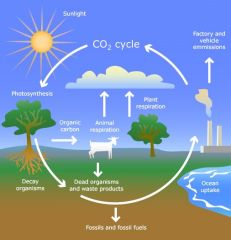
|
|
|
|
Watershed |
The land area that drains into a body ofwater.
|
|
|
|
How is the tundra biome similar to the desert |
Both receive very low amounts of precipitation resulting in limited plant growth
|
|
|
|
Biosphere |
the parts of the land, sea and atmosphere in which organisms are able to live |
|
|
|
Ecosystems |
community of living organisms in conjunction with non-living components (air, water, mineral soil) |
|
|
|
Sustainability |
capacity of ecosystems to maintain their essential functions and processes and retain their biodiversity in full measure over the long term |
|
|
|
Where do most ecosystems get their energy |
the sun |
|
|
|
% of suns energy reflected back into space |
30% |
|
|
|
% of suns energy that heats the Earth and causes weather |
40% |
|
|
|
% of suns energy used that causes water to evaporate |
25% |
|
|
|
What do plants and animals use as an energy source |
glucose |
|
|
|
First law of thermodynamics |
conservation of energy-total energy does not change, just changes in form |
|
|
|
Second law of thermodynamics |
every time energy changes in form, some is turned into a form that is not useful (heat) |
|
|
|
First organism in a food chain |
plant (producer, makes its own food, autotroph) |
|
|
|
Second organism in a food chain |
animals, heterotroph |
|
|
|
Trophic levels |
place on food chain level of consumer |
|
|
|
Food web |
connected food chains |
|
|
|
Pyramid of number |
a pyramid showing number of organisms of each species in an ecosystem advantages-easy disadvantages-not equal, not always a pyramid shape |
|
|
|
Pyramid of biomass |
uses mass of species, not just number Advantages-shows pyramid Disadvantages-more difficult to measure |
|
|
|
Pyramid of energy |
energy at each level Advantages-pyramid shape Disadvantages-difficult to measure.calculate |
|
|
|
Matter in ecosystems |
nature is the ultimate recycler atoms are constantly reorganized into new forms human cells-current estimate=replaced every 7 years must recycle atoms constantly |
|
|
|
Limiting factors of populations |
restricts size of a population can be biotic or abiotic (available habitat, breeding, predators, food |
|
|
|
4 basic factors to population size |
natality-number f births mortality-number of deaths immigration-move into ecosystem emigration-leave ecosystem |
|
|
|
Open vs closed ecosystem |
Open-all for factors, lake Ontario Closed-only natality and mortality, islands |
|
|
|
Carrying capacity |
number of individuals that can survive in an area affected by food, habitat, water, etc. |
|
|
|
Competition (relationships between species) |
both use same resources |
|
|
|
Predator (relationships between species) |
one animal uses the other as food |
|
|
|
Mutualism (relationships between species) |
both benefit |
|
|
|
Commensalism (relationships between species) |
one benefits and the other is unaffected |
|
|
|
Parasitism (relationships between species) |
one benefits from the harm done to another |
|
|
|
Range of tolerance |
conditions in which an organism can survive |
|
|
|
Measuring population- counting |
count each member of a population used for;small areas, stationary, humans Advantages-exact, simple Disadvantages-time, difficult for some species |
|
|
|
Measuring population- sampling |
count number in a small area and multiply for a larger ares used for;large populations, hard to access Advantages-less time, may be more accurate for mobile species Disadvantages-not likely exact, distribution (multiple samples) |
|
|
|
Measuring population- capture, release, recapture |
capture some of a species, tag with identifiers, release and recapture at a later time uses; birds, aquatic, mobile animals Advantages- faster, only method for very mobile species Disadvantages- may not be accurate |
|
|
|
A healthy ecosystem is in a stae of... |
equilibrium balanced or relatively constant |
|
|
|
Biomes |
similar abiotic and biotic factors over a large area equilibrium for a long time |
|
|
|
How can ecosystems with a biome change rapidly? |
fire, floods |
|
|
|
Succession |
gradual change in all ecosystem until equilibrium is established based on biome |
|
|
|
Primary succession |
nothing living to start volcanic islands |
|
|
|
Secondary succession |
after a disaster after a fire- low biodiversity to high |
|
|
|
Biodiversity |
number of different species healthy ecosystems have high biodiversity respond to changes |
|
|
|
Canada's biomes |
tundra boreal forest grassland temperate deciduous forest mountain forest |
|
|
|
Producers, consumers-mountain forest |
bear, elk, squirrel, cougar, pine, spruce, fern, salmon |
Besvpsfs |
|
|
Producers, consumers-grassland biome |
bison, coyote, fox, hawk, grass, milkweed, coneflower, prairie rose |
Bcfhgmcp |
|
|
Producers, consumers- temperate deciduous forest |
squirrel, bear, deer, mice, maple, oak, willow, birch |
Sbdmmowb |
|
|
Producers, consumers- boreal |
bear, weasel, wolf, hare, pine, spruce, blueberry, cranberry |
Bwwhpsbc |
|
|
Mass extinction |
many species become extinct in a short period of time, major planet change (asteroid hit) |
|
|
|
Gradual extinction |
species go extinct for several reasons |
|
|
|
Human extinction |
human cause species to become extinct
increases rate of extinction |
|
|
|
Natural extinction |
natural process of extinction |
|
|
|
Vulnerable (special concern) |
low or declining number or habitat (polar bears) |
|
|
|
Endangered |
in imminent danger of disappearing in Canada (swift fox) |
|
|
|
Threatened |
likely to become endangered if conditions do not change (humpback whalte) |
|
|
|
Extirapated |
no longer found in Canada but can be found in other parts of the world (paddlefish) |
|
|
|
Extinct |
no longer found on planet (great auk) |
|
|
|
Niche |
roll in environment |
|
|
|
Taxonomy |
science of identifying, naming and classifying species series of levels of classifying species based on similarities |
|
|
|
Five taxonomy kingdoms |
animals, monera (bacteria), plants, fungi, protists |
Ampfp |
|
|
Taxonomy classifying order |
kingdom, phylum, class, order, family, genus, species |
Kpcofgs |
|
|
Invasive species |
a species which is not native to an ecosystem and has harmful effects on the ecosystem predator, disease, competition sea lamprey, purple loosestrife |
|
|
|
How to control invasive species |
border controls chemical control- pesticides, gypsy moth, can kill native species Biological controls- other organisms, garlic mustard Physical barrier- fences |
|
|
|
Problems with controlling invasive species |
kill native species does not completely control |
|
|
|
Major abiotic factors in an aquatic ecosystem |
water sunlight |
|
|
|
% of freshwater ecosystems |
3% of fresh water on the planet 0.03% is free moving- river, sreams (lots of oxygen, dissolved at surface, very little photosynthesis) |
|
|
|
Lakes and pond zones |
1. littoral zone 2. limnetic zone 3. profundal zone |
Llp |
|
|
Littoral zone |

shore to depth where aquatic plants can grow
light reaches bottom |
|
|
|
Limnetic Zone |
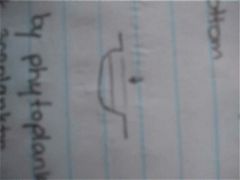
open water
light reaches
oxygen provided by phytoplankton (algae, zooplankton) |
|
|
|
Profundal zone |

no light
decaying matter
low oxygen
catfish, carp |
|
|
|
Factors in a marine ecosystem |
water sunlight salt tides |
|
|
|
Coastal zone |
from high water level to end of continental shelf highest biodiversity |
|
|
|
Intertidal |
between low and high tide water and land |
|
|
|
Unique marine environment |
where fresh and salt water mix high biodiversity- mix of biodiversity, ecotone coral reefs- high biodiversity, animals- skeletons, provides habitats for many species |
|
|
|
Agroecosystems |
human designed ecosystems for growing food |
|
|
|
Impacts of agroecosystems |
-biotic and abiotic factors -alter carrying capacity -not native species -lowers biodiversity -uniform abiotic factors -notsustainable -requires human control -pests -soil -water cycle |
|
|
|
Agroecosystems- impacts of non native species |
amount and size limited number of species 90% of food (plants= 15, animals-8) |
|
|
|
Agroecosystems- impact of lowering biodiversity |
monocultures of non-native species |
|
|
|
Pests |
Species we don't want |
|
|
|
Agroecosystems- impact of soil |
must be managed nutrients- disrupt cycle, removed by harvesting, replaced with fertilizer (natural- manure, artificial- runoff) |
|
|
|
Leaching |
fertilizer dissolves and enters aquatic ecosystems |
|
|
|
Agroecosystems- impact of water cycle |
irrigation- water from another ecosystem alter ecosystems- cranberries |
|
|
|
Alternative Farming |
crop rotation drought resistant species eat locally |
|
|
|
Oliogotrophic lakes |
deep, cold lakes with low biodiversity
|
|
|
|
Eutrophic lakes |
lakes are shallow, warm lakes with high biodiversity
|
|
|
|
Marine ecosystem zones |
Coastal zone
Oceanic zone Abyssal Plain |
|
|
|
Oceanic zone |
open water that light can reach
high levels of photosynthesis from marine algae |
|
|
|
Abyssal Plain |
open water that no light can reach to the bottom of the ocean – low biodiversity
|
|
|
|
How do plants and animal obtain nitrogen |
Plants obtain nitrogen from the soil while animals get nitrogen from their food sources.
|
|
|
|
Bioamplification (bioaccumulation) |
Bioamplification (bioaccumulation) is the amount of a toxic increasing in species in higher trophic levels.
|
|
|
|
Why can bioamplification be an issue in ecosystems |
causes issues when a pesticide, designed to affect something low in the food chain has a greater impact further up the food chain affecting all parts of an ecosystem in a harmful way instead of the targeted species.
|
|
|
|
Calculating capture-release-recapture |
tagged x recaptured/tagged + recaptured |
|
|
|
Photosynthesis cycle |
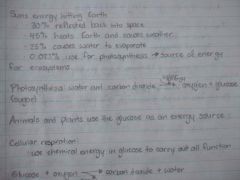
|
|
|
|
Cellular Respiration cycle |
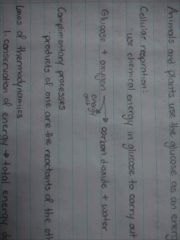
Use chemical energy in glucose to carry out all functions |
|
|
|
Marine ecosystem sketch |
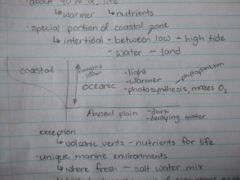
|
|

